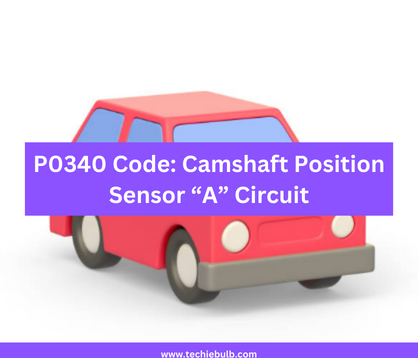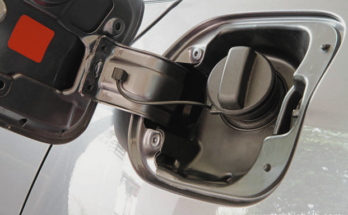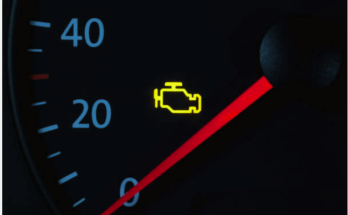When your vehicle’s diagnostic system flashes the P0340 code, it’s signaling trouble with the camshaft position sensor circuit—a vital component in engine performance. This code alerts you to potential disruptions in the camshaft’s position monitoring, which is crucial for precise fuel injection and ignition timing. Any disruption in this process can lead to a cascade of performance issues, from rough idling to decreased fuel efficiency.
Faulty camshaft position sensors, wiring issues, or timing belt or chain problems are some of the most common causes of the P0340 code. Diagnosis often involves a thorough inspection of the sensor, its wiring harness, and timing components.P0340 is a critical issue that needs to be addressed as soon as possible to keep your vehicle running optimally and avoid further damage. In this blog series we’ll go into more detail about P0340 Code causes symptoms and solutions so that you can face this issue head-on and get your vehicle running again.
What is the P0340 Error Code?

P0340 is a DTC (Diagnostic Trouble Code) for the Camshaft Position Sensor Circuit. The Camshaft is an important part of the modern engine management system. It monitors the position and the speed of the Camshaft. This information is important for the ECU to determine the exact timing of the fuel injection and the ignition. When a malfunction occurs in the ECU, it triggers P0340. The malfunction could be caused by a defective camshaft location sensor, a damaged circuit wiring or connectors, or a timing belt or a chain issue. The effects of P0340 can be severe. Poor engine idle, low fuel efficiency, misfiring, and even stalling can all be caused by P0340. Ignoring this code can worsen these issues and may lead to more serious engine problems.
What are the causes of P0340 Code?
One of the most common symptoms is rough engine idle, which is when the engine is operating unevenly or producing vibrations while stationary. You may also notice a decrease in general engine performance, such as reduced power output and slow acceleration.
Another common symptom is engine misfires, which are when the engine hesitates or jerks while accelerating or under load. Fuel efficiency may also suffer as a result of bad fuel injection timing, resulting in higher fuel consumption.
In more serious cases, the engine can stall unexpectedly, which can be a safety hazard, especially while driving or idle. You may also find it difficult to start the engine, with multiple attempts to initiate ignition.
The last diagnostic cue is the check engine light, which illuminates when there is a problem, including a P0340 code. It is important to recognize and address these symptoms as soon as possible to avoid further engine damage and optimal vehicle performance.
It is recommended to consult a qualified mechanic for proper diagnosis and repair to address the underlying issues that are causing this code.
How Serious Is the P0340 Error Code?
How serious a P0340 code is depends on how it’s handled and the underlying cause. While the code itself doesn’t pose a risk to your vehicle’s safety, it does indicate a problem with a critical component of your engine’s system.
If you ignore it, it can worsen issues that affect engine performance, fuel economy, and reliability. P0340 code symptoms may not seem like much at first, such as rough idling or reduced performance. But if you don’t address them right away, they can escalate into more serious issues like engine stalling or engine damage.
It’s important to address P0340 code as soon as possible to avoid further complications and costly repairs down the line. Whether it’s a defective sensor, wiring issue, or timing belt problem, you need to diagnose and fix it as soon as possible.
Can I Drive With a P0340 Code?
P0340 codes are dangerous and should not be driven with. While it may not be a direct safety hazard, it can be a sign that there is a problem with an important part of your vehicle’s engine system. If you ignore it, you could end up with a worse engine performance, lower fuel economy, and lower reliability. P0340 code symptoms can include rough idling or reduced engine power. It can even lead to engine stalling.
Driving with this code can be unpredictable and dangerous, especially in busy traffic or high speeds. Driving with P0340 unresolved could also lead to further damage to your engine, which could result in expensive repairs down the line. If you see P0340 on your vehicle, it’s a good idea to get it checked by a professional mechanic right away. They will be able to diagnose the problem and recommend repairs to make sure your vehicle runs safe and reliable.
How Simple is it to Diagnose a P0340 Code?

P0340 codes can vary in difficulty depending on the situation. While some can be easily fixed (e.g. by replacing a defective camshaft location sensor or fixing a loose connection), others require more in-depth testing and experience. A P0340 diagnostic is typically performed by a mechanic using a diagnostic scanner to obtain the trouble code. The mechanic then performs various tests to determine the exact root cause of the problem.
However, if the problem involves other components such as the timing belt, or chain, the process of diagnosing and fixing the problem may be more difficult and time consuming. While diagnosing and fixing P0340 codes isn’t always complicated, it does require specialized expertise and equipment. That’s why it’s usually best to work with a qualified mechanic to ensure that the problem is properly diagnosed and repaired.
How Difficult Is Inspecting a P0340 Code?
Inspecting a P0340 code typically involves a series of steps that require some level of technical knowledge and access to diagnostic tools. If you’re a mechanic or have experience with automotive repair, the inspection process will be relatively easy for you. However, if you’re not familiar with automotive systems, the process may be a bit more difficult.
To begin with, you’ll need to retrieve the P0340 trouble code from your vehicle’s onboard computer using a diagnostic scanner. This scanner will provide you with important information about the type of problem you’re facing, as well as the causes and symptoms of the problem. After you’ve retrieved the code, it’s time to do a visual inspection.
You’ll want to look for any signs of damage on the sensor’s wiring harness. For example, if the wires are frayed or corroded, this could be the cause of the issue. If you don’t see any visible damage, you may need to do more testing. For example, you may want to test the electrical connections of the sensor with a multimeter or run a scope test for the output signal of the sensor. All in all, while it’s not impossible to inspect P0340 codes, it is important to seek the help of a qualified mechanic.
Conclusion
To sum up, fixing P0340 error codes is essential for maintaining your vehicle’s performance and reliability. The P0340 code is a sign that there’s a problem with your camshaft location sensor circuit. This code can cause a variety of symptoms, such as rough idling and decreased engine performance. It’s important to diagnose and repair this code as soon as possible to avoid further damage to your engine. The best way to fix this issue is to seek the help of a qualified mechanic who can accurately diagnose and fix the underlying issues that are causing this code. Ignoring this code can lead to more serious issues and potential safety risks in the future. By addressing this issue as soon as possible, you’ll be able to keep your vehicle running smoothly and safely on the road.




